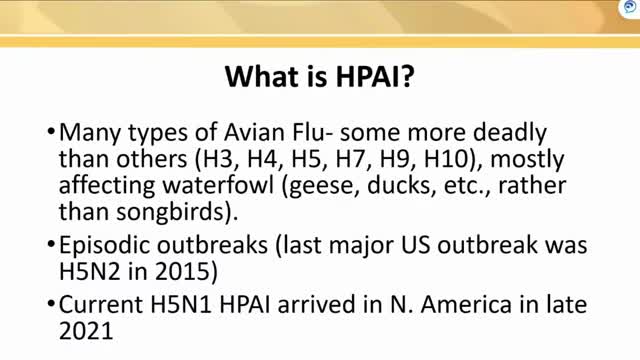
This article was created by AI using a video recording of the meeting. It summarizes the key points discussed, but for full details and context, please refer to the video of the full meeting. Link to Full Meeting
The session began with an overview of the different strains of avian flu, specifically highlighting H3, H4, H5, H7, H9, and H10. These strains predominantly affect waterfowl, such as geese and ducks, rather than songbirds commonly seen at feeders. The discussion noted a concerning rise in mortality among vultures, likely due to their consumption of infected waterfowl.
Participants were informed that the last significant outbreak of highly pathogenic avian flu occurred in 2015, involving the H5N2 strain. The current H5N1 strain, which arrived in North America in late 2021, has since impacted commercial flocks. Other strains, including H7N9 and H5N9, have also been detected, with H7N9 recently decimating a flock in Mississippi. The situation is dynamic, with the potential for rapid changes in the status of these outbreaks.
The webinar also addressed the migratory patterns of waterfowl, which can facilitate the spread of avian flu across continents. Birds migrating from the Arctic to South America and vice versa can introduce new strains to different regions, complicating control efforts.
Signs of avian influenza in poultry were discussed, including sudden deaths, purple discoloration, decreased egg production, and respiratory symptoms. The meeting also touched on the virus's impact beyond birds, noting reports of decreased milk production in dairy cattle and fatalities among various mammals, including domestic cats and marine mammals like sea lions.
In conclusion, the webinar emphasized the importance of vigilance among backyard flock owners and the need for ongoing monitoring of avian influenza. Participants were encouraged to stay informed as the situation evolves, highlighting the interconnectedness of wildlife health and agricultural practices.
Converted from Avian Flu for Backyard Flock Owners Webinar meeting on April 05, 2025
Link to Full Meeting
Comments
View full meeting
This article is based on a recent meeting—watch the full video and explore the complete transcript for deeper insights into the discussion.
View full meeting